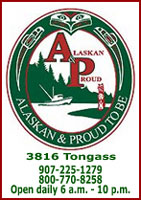|
Fish Factor 52 million hatchery produced fish projected to returnBy LAINE WELCH March 25, 2014
The 2013 Fisheries Enhancement Report by the AK Dept. of Fish and Game shows that a return of 112 million hatchery reared salmon contributed 36 percent to the state’s total salmon harvest. The breakdown by species was 63% for chum salmon, 38% for pinks, 23% for Chinook salmon, 22% for cohos and 5% of Alaska’s sockeye salmon catch can be credited to hatchery returns. Unlike farmed fish, which are crammed into nets or pens until they’re ready for market, Alaska salmon begin their lives in one of 35 state and/or privately run hatcheries and are released as fingerlings to the sea. Prince William Sound has the greatest amount of hatchery action - last year 80% of the Sound’s salmon catch was hatchery produced, including 88% of the chums and 80% of the pinks 45% of sockeye were hatchery produced. The hatchery catch was worth $113 million to PWS salmon fishermen, 68% of the total value. Kodiak outpaced Southeast for hatchery catches last year. Fish returns to the Island’s two hatcheries accounted for 35% of Kodiak’s total salmon catch, nearly triple from 2012. The value of $16 million was 26% of total exvessel value, an increase of $10 million. The hatchery catch breakdown was 12% chums, 20% coho, 15% sockeye and 38% pink salmon. At Southeast, hatcheries contributed 10% of the total salmon catch last year valued at $52 million, or 21% of the dockside value. The breakdown was 81% of chums, 32% of Chinook, 26% coho, 14% sockeye and 2% pinks. Nearly 761,000 hatchery-reared coho salmon returned to Southeast, the largest ever. At Cook Inlet, just one percent of both the sockeye and pink salmon harvests were hatchery produced valued at under $500,000. This year nearly 52 million hatchery produced fish are projected to return to Alaska. Crab crunch Lots of Tanner crab is coming out of Alaska this winter, popular in buffets and casual-dining restaurants throughout the country. Southeast Alaska wrapped up its best fishery in a decade with 80 crabbers hauling up one and a quarter million pounds in 11 days. At an average fishermen’s price of $2.70/lb the Tanner fishery is worth more than $3 million to the region. The snow crab coming out of the Bering Sea is a smaller cousin in the Tanner family – at one to two pounds, it is half the size of the Southeast crab. with no ice problems this year, The Bering Sea snow crab catch of 54 million pounds could be hauled up in a couple of weeks. The base price for snow crab of $2.15/lb is similar to last year, worth nearly $120 million to the 46 boats in the fishery. Alaska snow crab will soon face a bigger competitor than its arch rival Canada, which already produces double the Bering Sea volume. Now all signs are pointing to a huge, untapped snow crab supply in the Barents Sea. The Norway Marine Institute projects yearly snow crab catches of 25,000 metric tons - 75,000mt in the next 10 years, and possibly higher – that equals 55 million to 165 million pounds. Seafood.com reports that crabbing is underway and Norway and Russia are devising a management plan for the new snow crab fishery. Trident Seafoods is a uniquely American story; one of home town boy makes good, claims John Van Amerongen, author of Catching a Deckload of Dreams. It’s the story of Chuck Bundrant founder and CEO of Trident Seafoods. “Think of a guy who hops into a ’53 station wagon in the middle of winter in Tennessee and stops by to say good bye to family in Indiana and heads west,” Van Amerongen said in a phone interview. “That was in 1961 and I like to say he didn’t know the pointy end from the square end of a fish or a fishing boat. He had just heard that you could make enough money fishing in Alaska to pay your way through college which was very important to him at the time,” he added. Trident is now the largest source-to-table seafood company in North America. Pretty good for a guy who got his start in fish holds at Adak. “Literally that is where he got his start. So if you look at a beginning like that and see where he wound up, it’s a pretty amazing journey. So there was a great story there,” Van Am said. The Bundrant family asked John Van Am, as he is known in the industry, to write Chuck’s story. Van Am was the voice behind the Alaska Fisherman’s Journal for over two decades. His goal with the book, he said, was to give readers a seat at the table. “When I was a young journalist and editor at Alaska Fisherman’s Journal, there was always a special table at a bar or restaurant where the highliners or captains of industry were spilling a few drinks and letting the stories pour out too. And I’d be sitting at the reporters stool at the end of the bar. I finally got asked to join the table once in a while. And My goal was to create a seat at the table for readers.” Find Catching a Deckload of Dreams at the Trident Seafood website. Fish bits The Sitka roe herring fishery started March 20 and seiners took 5,000 tons in little over two hours. Three more openers are expected to catch the total herring harvest of 16,333 tons. The sales outlook for seafood is good for 2014. Progressive Grocer’s annual review of US retail counters said that for the first time in 20 years, not a single retailer projected decreased seafood for sales this year. Other positives were stronger demand for wild fish, certified sustainable and seasonal seafood choices. April 1 starts registration for take at home Fish Tech classes through the University of Alaska/Southeast at Sitka. Technicians are badly needed in jobs throughout the state. Ask about internships and scholarships.
Laine Welch ©2014 www.alaskafishradio.com
|
|||





